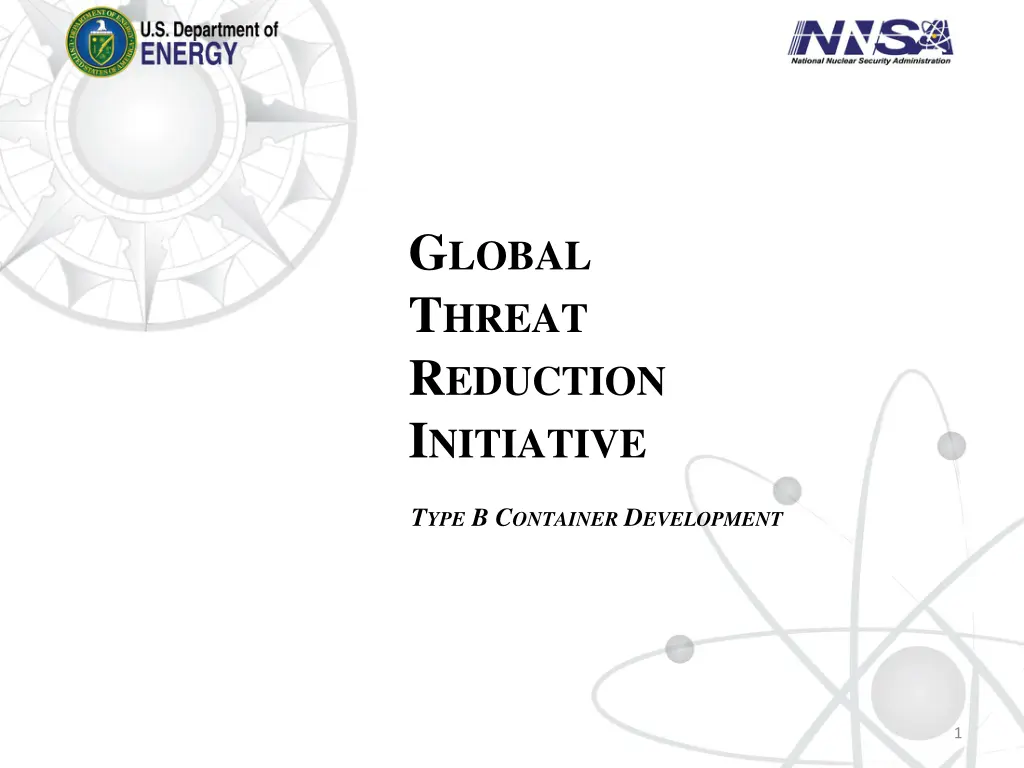
Global Threat Reduction Initiative Container Development Insights
Explore issues and solutions related to regulatory changes in Type B container development for the Global Threat Reduction Initiative. Learn about the challenges, solutions, and next steps in enhancing container designs and compliance.
Download Presentation

Please find below an Image/Link to download the presentation.
The content on the website is provided AS IS for your information and personal use only. It may not be sold, licensed, or shared on other websites without obtaining consent from the author. If you encounter any issues during the download, it is possible that the publisher has removed the file from their server.
You are allowed to download the files provided on this website for personal or commercial use, subject to the condition that they are used lawfully. All files are the property of their respective owners.
The content on the website is provided AS IS for your information and personal use only. It may not be sold, licensed, or shared on other websites without obtaining consent from the author.
E N D
Presentation Transcript
GLOBAL THREAT REDUCTION INITIATIVE TYPE B CONTAINER DEVELOPMENT 1
Issues- Regulatory Changes In a January 2004 rulemaking, NRC adopted revised regulations to harmonize with the 1996 edition of the IAEA regulations. Many of the Type B packages designed several decades ago and did not meet these new international standards. Packages that match IAEA regulations only fit a small number of devices (<10%) and are expensive to use due to limited availability. By 2009, there were little to no developments for new general-use packages but rather reliance on device-specific packages for transport. Type B packages that met the new standards are expensive to lease or buy, and are available only in limited quantities or are in high demand, making availability uncertain. Other limitations include weight or volume restrictions, payload activity limits are too low, and restrictions on form of materials. 2
GTRI Solutions International Design and construct an unshielded leak tight container, used primarily in conjunction with the International Atomic Energy Agency (IAEA) Transportable Hot Cell, to ship teletherapy and/or irradiator sources using the IAEA Long Term Storage Shield (LTSS) as an inner container. Domestic Design and construct a large shielded container capable of transporting a majority of the GTRI/OSRP high-activity, beta/gamma device backlog. 3
435 B Little B Unshielded, leak tight container designed for use with IAEA LTSS. Package Description Empty weight 4,940 lbs (~2,225 Kg) Total weight 10,100 lbs (~4,535 Kg) Shielded devices w/ Cs-137 or Co-60, internal container max weight 3,500 lbs (~1,590 Kg) LTSS Payload: Cs, Sr, Ir, Se Ra, Am Pu and small neutron sources LTSS Payload Activities: 12,970 Ci (~480 TBq) Co-60 and 14,000 Ci (~520 TBq) Cs-137, 200 W limit External dimensions: 83 in (209 cm) H x 70 in (179 cm) OD at base Internal Cavity: 60 in (152 cm) H x 43 in (110 cm) in ID Transport by truck, rail, ship, air Certificate of Compliance issued June 2014. 4
Next Steps Obtain a CoCA for the 435B from DOT Provide copies of the SAR and design drawings to IAEA making container available internationally Including additional content/devices to the 435B Fabrication and use of 435B anticipated in 2015 Devices Currently Certified as Payload Gammator 50B, B, B34, G-50-B Gammator M34 Gammator M38 Gammacell 1000 (GC-1000) - Models A through D - Elite A through D, Type I and Type II Gammacell 3000 (GC-3000) - Elan A through C, Type I and Type II Gammacell-40 (GC-40 Exactor) IAEA LTSS 5
380 B Big B Shielded transport container designed for shipping irradiating devices that are not certified payload in any other container and documentation (QA) is not available. Proposed Design Parameters Payload weight 4,535 Kg Co, Cs, Sr, Ir, Ra Am Pu and Depleted Uranium Approximately 275 TBq Co-60 Leak tight NCT and HAC Transport by truck, rail, ship, air External dimensions 330 cm H x 254 cm OD Internal Cavity 162 cm H x 113 cm ID Empty weight 35,835 Kg Half Scale testing began the week of August 18th. We anticipate submittal of the Safety Analysis Report (SAR) to the NRC in third quarter of 2015 and receipt of the CoC by mid 2016. 6
Packaging Course In an effort to increase the number of service provides that are licensed to prepare devices for transport, GTRI has begun working with Southwest Research Institute (SwRI) to develop a course with associated training materials. A CRCPD Task Force was recently formed to investigate the license requirements and reciprocity agreements necessary for service providers to perform this work. The initial courses will focus on Pharmalucence, JL Shepherd, and MDS Nordion/Best Medical devices. Continuing education credits are being investigated for this course. 7
Contacts Temeka Taplin Federal Program Manager Email: Temeka.Taplin@nnsa.doe.gov Office: 202-586-9265 John Zarling OSRP Program Manager Email: jcz@lanl.gov Office: 505-665-3668 8
